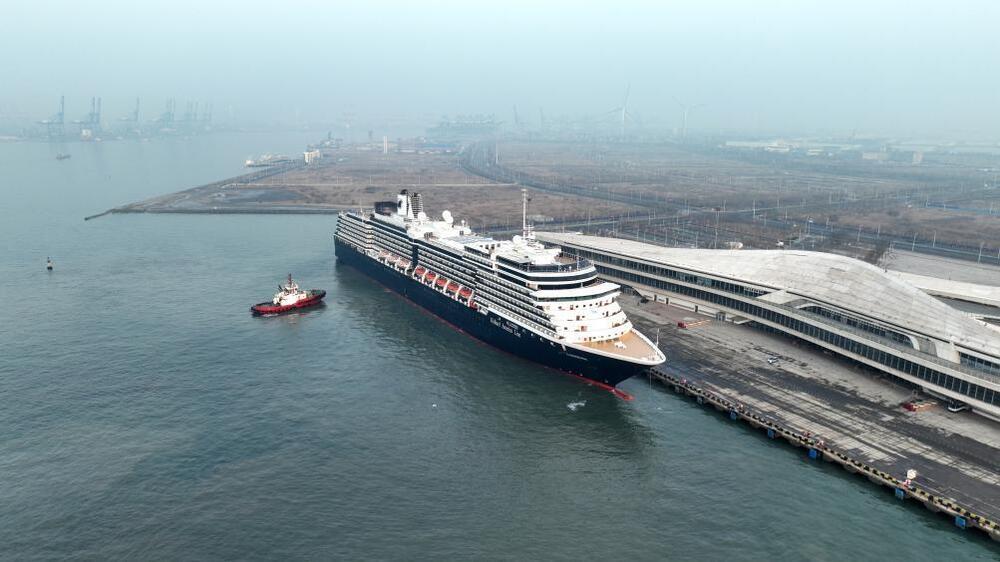
Images | Xinhua
China on Wednesday enforced a policy allowing visa-free entry of foreign tourist groups aboard cruise ships via all cruise ship ports along the country's coastline,
Xinhua reports.
Tourist groups each consisting of two foreigners or more, and organized or received by Chinese travel agencies, can enter China visa free on board cruise ships via the cruise ports in 13 Chinese cities, including Shanghai, Tianjin, Guangzhou and Sanya, according to the National Immigration Administration (NIA).
The tourists can stay in China for no longer than 15 days. While in China, they can visit coastal provinces, municipalities and autonomous regions as well as Beijing, an NIA statement noted.
Additionally, the NIA announced that seven cruise ports, namely Dalian, Lianyungang, Wenzhou, Zhoushan, Guangzhou, Shenzhen, and Beihai, have been designated as visa-free transit ports for nationals from 54 countries.
This move facilitates the transit and departure of foreign travelers from these ports via cruise ships under China's visa-free transit policy, the statement noted.
To make cruise entry and exit procedures more convenient, the NIA has introduced a range of measures focusing on facilitating clearance for foreign cruise passengers, crew landing, and cruise maintenance, among other services, according to Mao Xu, a senior NIA official.
The adoption of the 15-day visa-free policy for international cruise tour groups came after years of successful trials.
The pilot trial of this policy began in Shanghai in October 2016, allowing foreign cruise travelers to explore Shanghai, Beijing, and other cruise port cities, as well as their neighboring cities.
With more options in entry ports and expanded visit areas, foreign visitors will have a richer experience in China, boosting the country's appeal to international tourists, said Zhu Jialiang, an associate professor with Xiamen University.
With a coastline stretching 18,000 km, China boasts steadily improving port infrastructure, abundant tourism resources, and rapid growth of the service industry, making it a major stop for international cruise liners.
Currently, China's inbound cruise tourism market is experiencing strong momentum. From February to April, over 14,000 tourists from at least 47 countries and regions visited China aboard cruise ships, according to the Ministry of Culture and Tourism.
Zhu highlighted the move's role in further bolstering the development of the cruise economy in China's coastal regions.
Official data showed that since the inception of the pilot initiative, Shanghai has experienced an annual average growth of 10 percent in cruise tourist arrivals.
The expanded adoption of the policy will attract more foreign cruise ships to Chinese cruise ports, driving port development and domestic consumption, Zhu said.
Echoing Zhu's view, Fiona Ma from Singapore-based travel agency EU Holidays said the expanded policy offers a huge opportunity for Singaporean outbound travel planners like her.
She is expecting more tourists from various countries to choose Singapore -- a major hub for international cruise tours -- as their starting point to explore China.
The visa policies announced on Wednesday represent China's latest efforts to honor its commitment to opening its market to the world and enhancing global exchanges, observers said.
Over the years, the Chinese government has endeavored to make visiting China easier for foreign nationals.
By the end of early March, China had established reciprocal visa-exemption agreements with 157 countries, covering different types of passports. Meanwhile, China has reached agreements with 44 countries to simplify visa procedures.
The moves have yielded tangible results. During the Spring Festival holiday in February, the number of inbound tourists to China reached 3.23 million. Notably, there was a significant increase in tourists from countries such as France, Germany and Malaysia.
During the just-ended five-day May Day holiday, China saw 779,000 trips by travelers from abroad, almost doubling the figure for the same period last year.
Li Liangyi, president of Singapore-based China Express Travel Pte. Ltd., noted the changes since China resumed its visa exemption policy for Singaporean passport holders in July 2023. "The number of Singaporeans traveling to China has been steadily increasing," Li said.
Besides, efforts have been made to improve foreign tourists' travel experience in China. For instance, Chinese authorities have rolled out specific measures to facilitate foreigners using mobile payment while visiting China.
The introduction of policies and measures catering to foreign visitors' needs further demonstrates China's willingness to open up," said Su Xiaohui, an expert with the China Institute of International Studies.

